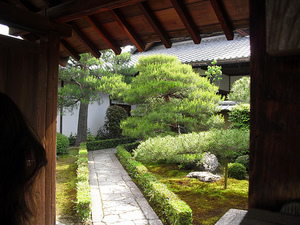Difference between revisions of "Sangen-in"
From SamuraiWiki
Jump to navigationJump to search| Line 7: | Line 7: | ||
[[Shun'oku Soen|Shun'oku Sôen]], the first abbot of Sangen-in, instructed a number of famous figures in the way of [[Zen]], including [[Hasegawa Tohaku|Hasegawa Tôhaku]], [[Kobori Enshu|Kobori Enshû]], [[Furuta Oribe]], and [[Tonai Kenchu|Tônai Kenchû]]. | [[Shun'oku Soen|Shun'oku Sôen]], the first abbot of Sangen-in, instructed a number of famous figures in the way of [[Zen]], including [[Hasegawa Tohaku|Hasegawa Tôhaku]], [[Kobori Enshu|Kobori Enshû]], [[Furuta Oribe]], and [[Tonai Kenchu|Tônai Kenchû]]. | ||
| − | [[Takuan]], [[Sen Sotan|Sen Sôtan]], and others also studied here, and the temple grounds contain the graves of Shun'oku, Mitsunari, Tadamasa, Kenchû, and Oribe. | + | [[Takuan Soho|Takuan Sôhô]], [[Sen Sotan|Sen Sôtan]], and others also studied here, and the temple grounds contain the graves of Shun'oku, Mitsunari, Tadamasa, Kenchû, and Oribe. |
The temple is generally not open to the public. | The temple is generally not open to the public. | ||
Latest revision as of 02:15, 16 May 2018
- Founded: 1589
- Japanese: 三玄院 (Sangen-in)
Sangen-in is a sub-temple of Daitoku-ji in Kyoto, founded in 1589 by Ishida Mitsunari, Asano Yukinaga, and Mori Tadamasa (younger brother of Mori Ranmaru).
Shun'oku Sôen, the first abbot of Sangen-in, instructed a number of famous figures in the way of Zen, including Hasegawa Tôhaku, Kobori Enshû, Furuta Oribe, and Tônai Kenchû.
Takuan Sôhô, Sen Sôtan, and others also studied here, and the temple grounds contain the graves of Shun'oku, Mitsunari, Tadamasa, Kenchû, and Oribe.
The temple is generally not open to the public.
References
- Official plaques on site.
